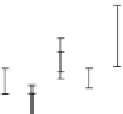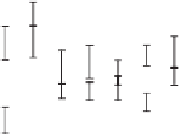Agriculture Reference
In-Depth Information
(A) Untilled
20
16
12
8
Control
Fertilized
4
0
(B) Annually Tilled
20
16
12
8
4
0
1
23456 789101112131415161718192021
Years after Abandonment
Figure 7.6
. Temporal changes in species richness (number of species per harvested sample)
in the Disturbance by N-Fertilization Experiment in the MCSE Early Successional system
in control (unfertilized) and fertilized (nitrogen added) treatments in the A) untilled, suc-
cessional plots and B) annually tilled plots. The area sampled varied for the first 3 years
(Yr. 1 = 0.2 m
2
, Yrs. 2 and 3 = 0.3 m
2
); from Yr. 4 onward sampling area was 1.0 m
2
; Year
1 = 1989. Values are means ± SE, n=6.
varied in abundance over time (Dickson and Gross 2013).
Solidago
(goldenrod)
species, which initially made up over 80% of the tall-runner biomass in these fields,
declined in abundance after 5 years. The reemergence of
S. canadensis
and other
tall runners in these fields after 14 years coincided with a decline in species richness
in fertilized treatments (Dickson and Gross 2013).
The delayed effect of fertilization on species richness in untilled plots of the
MCSE Early Successional system may be a consequence of the low abundance of
C
4
grasses and greater abundance of herbaceous perennial dicots and C
3
grasses
(Table 7.4), as compared to other successional grasslands in the area (see Gross
and Emery 2007; Clark et al. 2007). Cross-site synthesis work has shown that
there is an environmental context to species responses to N addition (Pennings
et al. 2005). For example,
Elymus (
formerly
Agropyron) repens
(quackgrass), a
nonnative C
3
grass that dominates following fertilization of successional fields
at Cedar Creek LTER in Minnesota (Tilman 1984, 1987), occurs in—but does
not dominate—the fertilized MCSE Early Successional plots at the KBS LTER


































































































